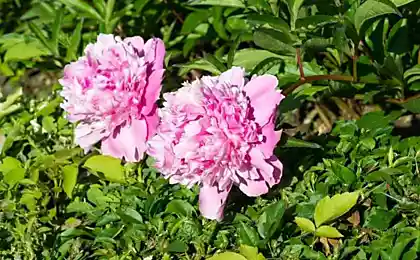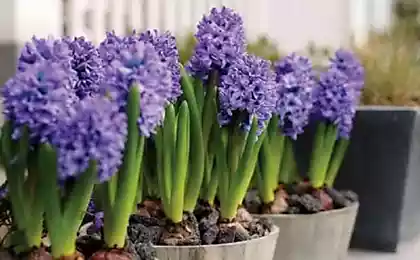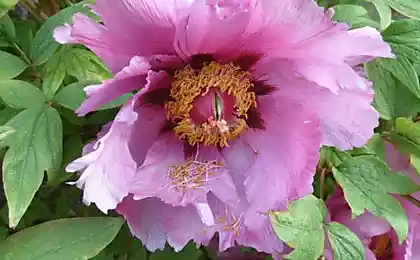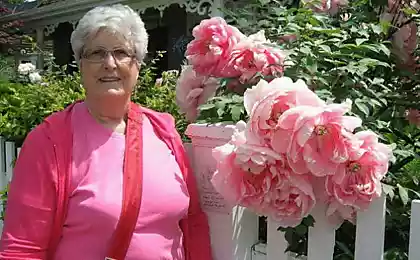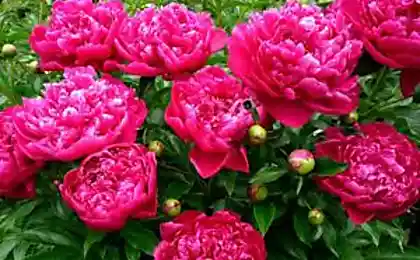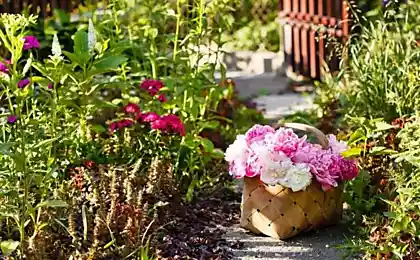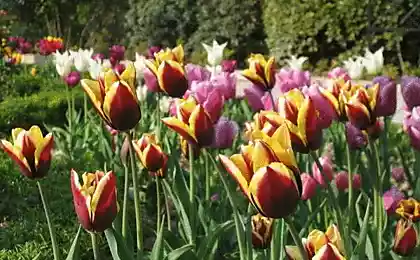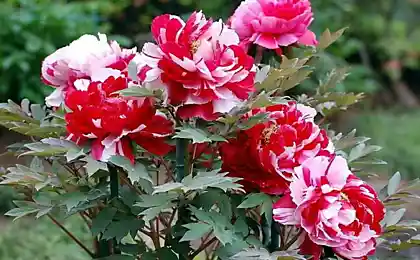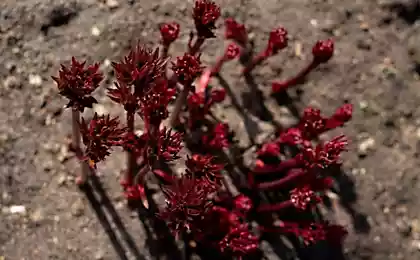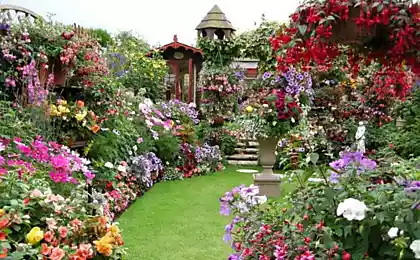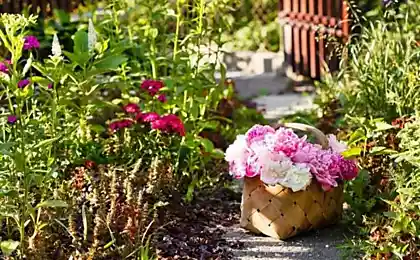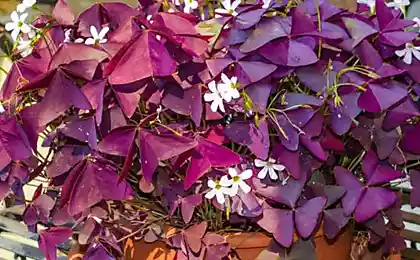445
Peony is the flower of prosperity
The Chinese consider the tree peony the king of flowers. His image is an integral part of Chinese culture. Gardens peonies since ancient times, arranged at first in churches and later in the palaces of the Emperor and the nobles.
For many hundreds of years, China was a huge number of varieties of tree peonies with flowers of different colors. Very large (10-20 cm in diameter), a bit like poppies flowers vsypayut bushes in the spring and early summer. The famous gardens of peonies during the flowering of these plants serve as a place of pilgrimage for many tourists and flower lovers. In China, there are still flowering specimens, whose age is counted in centuries.
Shrub tree peony "Shimane Chojuraku"
Chinese curiosity, the First European to see the miracle of peonies, was Robert fortune, the famous English naturalist and hunter plants. Tree peonies came to Europe relatively late, in the nineteenth century.
They quickly gained popularity, but just as quickly lost it, because farming was not so simple. Over time, the Chinese wonder was only hot in the gardens of enthusiasts, once and for all fell in love with flowers. These enthusiastic people have created the European varieties of tree peonies, contained nurseries.
Currently in Europe again erupted interest to this group of peonies, their collections are increasingly found on the flower show, planting in gardens, parks, lawns.
Tree peonies are very popular in USA and Canada. In Russia, they were in 1863, and for nearly a hundred years was grown as pot culture in cold greenhouses.
Since the mid-twentieth century in the Botanical gardens of Moscow and St. Petersburg were working on the zoning and selection of tree peonies, aimed at obtaining cold-resistant varieties. Currently, the plants bought in nurseries to those gardens with grown successfully in home gardens of Central Russia.
Other types of Close relatives peony tree are yellow peony (P. lutea) and Delve (P. Delavayi), also a native of China. Both species – deciduous shrubs to 2 m tall. They have a beautiful openwork foliage, but the flowers are much smaller than the pion tree, only 6-10 cm in diameter.
The yellow peony flowers are bright yellow, peony, Delawa – dark red, sometimes almost brown. Both species bloom in late spring and early summer and look very exotic, not only during flowering.
Our reference
Peony tree or subshrub (Paeonia suffruticosa), originates from China. Many botanists believe that this species has a hybrid origin and set it wild ancestors it is currently impossible. This view is not without reason, as tree peonies are cultivated in China for millennia.
In the color of flowers of peony, Delave frequent brown tones
Proper placement is the Best time for planting – the second half of August – September. The matter must be approached responsibly because of this shrub, as its herbaceous cousin, it is very important the correct placement, not least because one can grow in one place Bush may be many decades.
At low groundwater levels (below 2 m) the planting hole should be in the form of a cone 70 cm deep and in diameter. On the bottom of a stack of gravel, broken bricks or coarse sand layer 20-30 cm If the soil is acidic, make 200-300 g of lime or bone meal. Then fill the cone with soil, mixing in heavy clay sand, sandy – clay. On the mound place the seedling and fill the hole with water to the brim. When the water is absorbed, a pit covered with earth so that the root collar peony was at the level of the soil.
Inoculated plants are placed in such a manner that the site of inoculation was located at 10-15 cm below the soil surface, then in 2-3 years the Scion forms its own roots.
If the water table near the soil surface, tree peonies need to be planted in the raised beds.
Distance between instances is not less than 1,5 m. the Land around is planted Bush should remain loose, not rammed.
Our advice
✦ Tree peonies need Sunny or half-shaded place, sheltered from strong winds, away from large trees. The last condition is due to the fact that the roots of woody plants will compete with the roots of the peony, to deprive it of nutrients and moisture.
✦ The soil requires a light, nutritious, with alkaline reaction and good drainage.
Peony "Tama-Sudare"
Crop In the care of tree peonies plays an important role for the crop. Every spring before the growing season remove dead and weak shoots and old ones are pruned, leaving stumps height of 10 cm.
In China every 20 years to carry out rejuvenation pruning when the shrub is cut entirely, almost to the level of the soil. After flowering is recommended to cut withered shoots to the top of the axillary buds.
If you want seeds, leave one or two of the ensuing fruit. In this approach, abundant fructification does not exhaust the plant, and next year the peony will not bloom worse.
Particular care Other care for tree peonies is weeding and loosening tree trunks, and fertilizing. First feeding is carried out before flowering (complex mineral fertilizer). Excess nitrogen fertilizers can be harmful because it increases the risk of the disease Botrytis. Additional watering of plants need only in dry and hot weather, and before application of fertilizers.
The sort of "High Noon" is one of the most beautiful yellow peonies
The division of the Bush Adult tree peonies do not like being transplanted. If you need to move the hive to a new location, dig it with the largest possible ball of soil, so as not to injure the roots.
If necessary, dividing the shrub roots, on the contrary, we recommend that you thoroughly clean from the earth, cut out diseased and dead, and long healthy be shortened by one third. Slices treated with a solution of potassium permanganate and sprinkled with powdered charcoal.
Bush cut into a few telenok, each of which must have at least one kidney. All dry and weak shoots are removed completely damaged cut to the first healthy Bud. Before planting the roots telenok half an hour dipped in clay mash.
Tree peony "Kokuryu-Nishiki"
Shelter for the winter Tree peony in the middle of Russia requires shelter for the winter, although the mild winter unsheeted instances transferred without loss. In severe frosts the plants without cover frosted over to the snow level, but quickly recovered in the spring, though of course not in bloom.
To be sure in the safety of planting in the fall low instances covered with dry leaves and spruce branches, the higher branch bends to the ground, fastened and covered in the same way. And finally, the large adult bushes, the branches of which it is impossible to bend, covered by jute bags, pre-stuffed between twigs dry leaves or shavings. Spring frosts can damage the started into growth buds of the tree peonies, so at night the bushes it is recommended to cover lutrasilom.
Our reference
Peonies and yellow, Delawa in Central Russia frosted over to the snow level, but quite easy to recover. Pruning damaged over the winter shoots is recommended after leafing because at first glance, alive branches are almost indistinguishable from the dried.
Dangerous diseases Tree peonies are more resistant to diseases and pests than their herbaceous counterparts. The most dangerous disease is considered to be gray mold. The affected stems are immediately removed and burned, and the surviving part of the plant should be sprayed with a solution of potassium permanganate or copper sulfate.
Root decay is more common in old bushes and can be transmitted delendam during the transplant. Therefore, the affected areas are carefully cut and place slices fall asleep with powdered charcoal and treated with a solution of copper sulphate or potassium permanganate. Against brown spot helps spraying with a solution of Bordeaux liquid, as well as timely removal of diseased leaves, which have to be incinerated.
Seeds peony yellow
Breeding Breed tree peony peonies by dividing the Bush, cuttings and seeds.
Seed propagation is quite time-consuming, but the resulting seedlings will be much better adapted to growth conditions than that obtained vegetatively. For a long time the seeds germinate, the germination percentage is usually small. Sowing fresh seed gives the best results. It is carried out in September directly in the ground, plants bloom for 4-6 year. If the seeds were collected from varietal instance, plants will not necessarily inherit the properties, but can please unusual color of the flowers.
The division of the Bush are the easiest to propagate tree peonies by dividing the Bush. Most suitable for this procedure are 5 to 6 years old plants. Bush is dug in August, clean the roots from the ground and neatly divided into parts.
Each Zelenka must have at least 3-5 buds of renewal, located at the base of shoots and well developed roots. Planting material should be planted in a permanent place.
Tree peony – survivor. In China, there are five hundred copies, which each spring blossom with delight, and even century-old bushes were not uncommon Cuttings Semilignified cuttings are cut in the second half of June. Have tree peonies do not take the plot of escape with two nodes and a Bud with a leaf and a small piece of wood.
Lamina is cut half to reduce evaporation. These "eyes" are planted in boxes with a mixture of peat and sand in equal parts at a depth of 1.5 cm Substrate should be moist. Landing useful spray. In late September, the rooted cuttings are transplanted into pots until spring and kept at low positive temperatures and moderate watering. In soil planted in the spring, when the threat of frost passes.
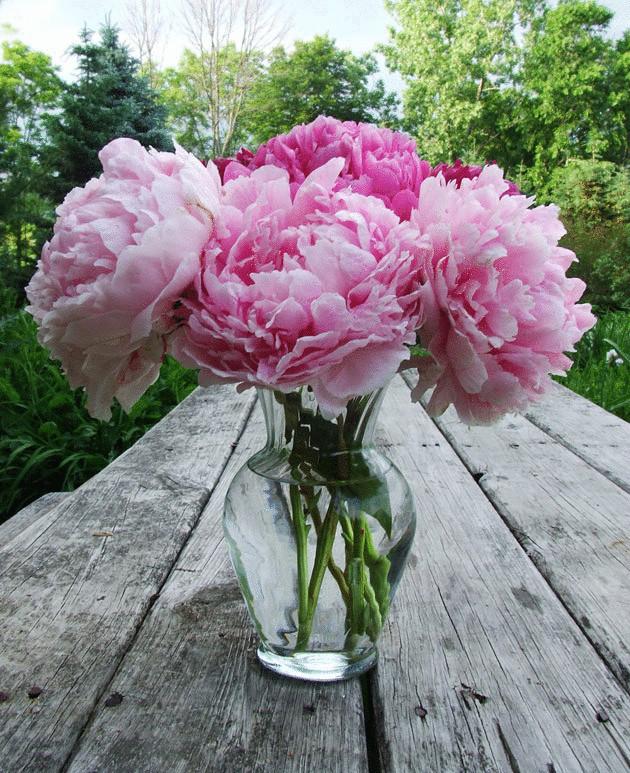
Source: www.ldacha.ru
For many hundreds of years, China was a huge number of varieties of tree peonies with flowers of different colors. Very large (10-20 cm in diameter), a bit like poppies flowers vsypayut bushes in the spring and early summer. The famous gardens of peonies during the flowering of these plants serve as a place of pilgrimage for many tourists and flower lovers. In China, there are still flowering specimens, whose age is counted in centuries.
Shrub tree peony "Shimane Chojuraku"
Chinese curiosity, the First European to see the miracle of peonies, was Robert fortune, the famous English naturalist and hunter plants. Tree peonies came to Europe relatively late, in the nineteenth century.
They quickly gained popularity, but just as quickly lost it, because farming was not so simple. Over time, the Chinese wonder was only hot in the gardens of enthusiasts, once and for all fell in love with flowers. These enthusiastic people have created the European varieties of tree peonies, contained nurseries.
Currently in Europe again erupted interest to this group of peonies, their collections are increasingly found on the flower show, planting in gardens, parks, lawns.
Tree peonies are very popular in USA and Canada. In Russia, they were in 1863, and for nearly a hundred years was grown as pot culture in cold greenhouses.
Since the mid-twentieth century in the Botanical gardens of Moscow and St. Petersburg were working on the zoning and selection of tree peonies, aimed at obtaining cold-resistant varieties. Currently, the plants bought in nurseries to those gardens with grown successfully in home gardens of Central Russia.
Other types of Close relatives peony tree are yellow peony (P. lutea) and Delve (P. Delavayi), also a native of China. Both species – deciduous shrubs to 2 m tall. They have a beautiful openwork foliage, but the flowers are much smaller than the pion tree, only 6-10 cm in diameter.
The yellow peony flowers are bright yellow, peony, Delawa – dark red, sometimes almost brown. Both species bloom in late spring and early summer and look very exotic, not only during flowering.
Our reference
Peony tree or subshrub (Paeonia suffruticosa), originates from China. Many botanists believe that this species has a hybrid origin and set it wild ancestors it is currently impossible. This view is not without reason, as tree peonies are cultivated in China for millennia.
In the color of flowers of peony, Delave frequent brown tones
Proper placement is the Best time for planting – the second half of August – September. The matter must be approached responsibly because of this shrub, as its herbaceous cousin, it is very important the correct placement, not least because one can grow in one place Bush may be many decades.
At low groundwater levels (below 2 m) the planting hole should be in the form of a cone 70 cm deep and in diameter. On the bottom of a stack of gravel, broken bricks or coarse sand layer 20-30 cm If the soil is acidic, make 200-300 g of lime or bone meal. Then fill the cone with soil, mixing in heavy clay sand, sandy – clay. On the mound place the seedling and fill the hole with water to the brim. When the water is absorbed, a pit covered with earth so that the root collar peony was at the level of the soil.
Inoculated plants are placed in such a manner that the site of inoculation was located at 10-15 cm below the soil surface, then in 2-3 years the Scion forms its own roots.
If the water table near the soil surface, tree peonies need to be planted in the raised beds.
Distance between instances is not less than 1,5 m. the Land around is planted Bush should remain loose, not rammed.
Our advice
✦ Tree peonies need Sunny or half-shaded place, sheltered from strong winds, away from large trees. The last condition is due to the fact that the roots of woody plants will compete with the roots of the peony, to deprive it of nutrients and moisture.
✦ The soil requires a light, nutritious, with alkaline reaction and good drainage.
Peony "Tama-Sudare"
Crop In the care of tree peonies plays an important role for the crop. Every spring before the growing season remove dead and weak shoots and old ones are pruned, leaving stumps height of 10 cm.
In China every 20 years to carry out rejuvenation pruning when the shrub is cut entirely, almost to the level of the soil. After flowering is recommended to cut withered shoots to the top of the axillary buds.
If you want seeds, leave one or two of the ensuing fruit. In this approach, abundant fructification does not exhaust the plant, and next year the peony will not bloom worse.
Particular care Other care for tree peonies is weeding and loosening tree trunks, and fertilizing. First feeding is carried out before flowering (complex mineral fertilizer). Excess nitrogen fertilizers can be harmful because it increases the risk of the disease Botrytis. Additional watering of plants need only in dry and hot weather, and before application of fertilizers.
The sort of "High Noon" is one of the most beautiful yellow peonies
The division of the Bush Adult tree peonies do not like being transplanted. If you need to move the hive to a new location, dig it with the largest possible ball of soil, so as not to injure the roots.
If necessary, dividing the shrub roots, on the contrary, we recommend that you thoroughly clean from the earth, cut out diseased and dead, and long healthy be shortened by one third. Slices treated with a solution of potassium permanganate and sprinkled with powdered charcoal.
Bush cut into a few telenok, each of which must have at least one kidney. All dry and weak shoots are removed completely damaged cut to the first healthy Bud. Before planting the roots telenok half an hour dipped in clay mash.
Tree peony "Kokuryu-Nishiki"
Shelter for the winter Tree peony in the middle of Russia requires shelter for the winter, although the mild winter unsheeted instances transferred without loss. In severe frosts the plants without cover frosted over to the snow level, but quickly recovered in the spring, though of course not in bloom.
To be sure in the safety of planting in the fall low instances covered with dry leaves and spruce branches, the higher branch bends to the ground, fastened and covered in the same way. And finally, the large adult bushes, the branches of which it is impossible to bend, covered by jute bags, pre-stuffed between twigs dry leaves or shavings. Spring frosts can damage the started into growth buds of the tree peonies, so at night the bushes it is recommended to cover lutrasilom.
Our reference
Peonies and yellow, Delawa in Central Russia frosted over to the snow level, but quite easy to recover. Pruning damaged over the winter shoots is recommended after leafing because at first glance, alive branches are almost indistinguishable from the dried.
Dangerous diseases Tree peonies are more resistant to diseases and pests than their herbaceous counterparts. The most dangerous disease is considered to be gray mold. The affected stems are immediately removed and burned, and the surviving part of the plant should be sprayed with a solution of potassium permanganate or copper sulfate.
Root decay is more common in old bushes and can be transmitted delendam during the transplant. Therefore, the affected areas are carefully cut and place slices fall asleep with powdered charcoal and treated with a solution of copper sulphate or potassium permanganate. Against brown spot helps spraying with a solution of Bordeaux liquid, as well as timely removal of diseased leaves, which have to be incinerated.
Seeds peony yellow
Breeding Breed tree peony peonies by dividing the Bush, cuttings and seeds.
Seed propagation is quite time-consuming, but the resulting seedlings will be much better adapted to growth conditions than that obtained vegetatively. For a long time the seeds germinate, the germination percentage is usually small. Sowing fresh seed gives the best results. It is carried out in September directly in the ground, plants bloom for 4-6 year. If the seeds were collected from varietal instance, plants will not necessarily inherit the properties, but can please unusual color of the flowers.
The division of the Bush are the easiest to propagate tree peonies by dividing the Bush. Most suitable for this procedure are 5 to 6 years old plants. Bush is dug in August, clean the roots from the ground and neatly divided into parts.
Each Zelenka must have at least 3-5 buds of renewal, located at the base of shoots and well developed roots. Planting material should be planted in a permanent place.
Tree peony – survivor. In China, there are five hundred copies, which each spring blossom with delight, and even century-old bushes were not uncommon Cuttings Semilignified cuttings are cut in the second half of June. Have tree peonies do not take the plot of escape with two nodes and a Bud with a leaf and a small piece of wood.
Lamina is cut half to reduce evaporation. These "eyes" are planted in boxes with a mixture of peat and sand in equal parts at a depth of 1.5 cm Substrate should be moist. Landing useful spray. In late September, the rooted cuttings are transplanted into pots until spring and kept at low positive temperatures and moderate watering. In soil planted in the spring, when the threat of frost passes.

Source: www.ldacha.ru
